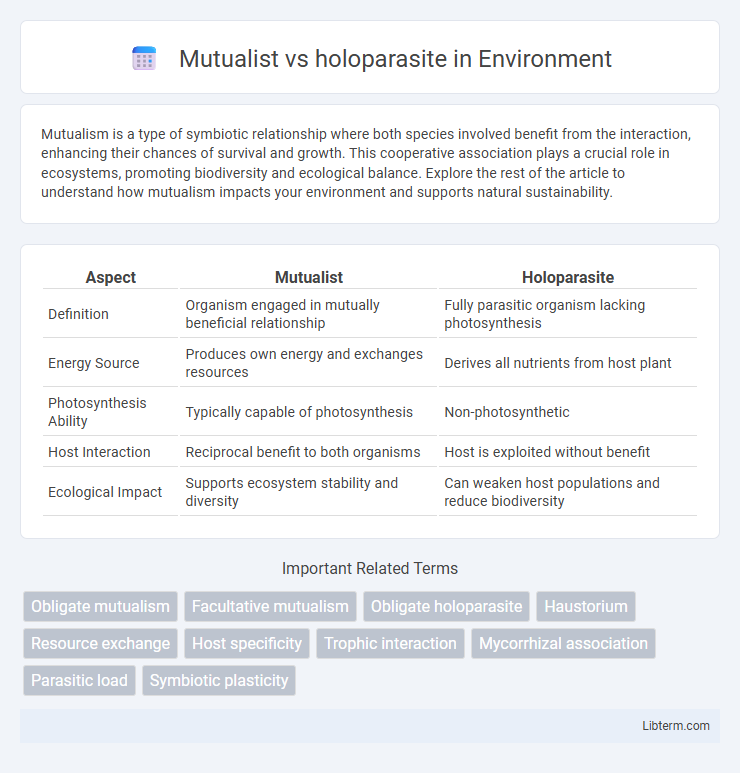Mutualism is a type of symbiotic relationship where both species involved benefit from the interaction, enhancing their chances of survival and growth. This cooperative association plays a crucial role in ecosystems, promoting biodiversity and ecological balance. Explore the rest of the article to understand how mutualism impacts your environment and supports natural sustainability.
Table of Comparison
| Aspect | Mutualist | Holoparasite |
|---|---|---|
| Definition | Organism engaged in mutually beneficial relationship | Fully parasitic organism lacking photosynthesis |
| Energy Source | Produces own energy and exchanges resources | Derives all nutrients from host plant |
| Photosynthesis Ability | Typically capable of photosynthesis | Non-photosynthetic |
| Host Interaction | Reciprocal benefit to both organisms | Host is exploited without benefit |
| Ecological Impact | Supports ecosystem stability and diversity | Can weaken host populations and reduce biodiversity |
Introduction to Plant Interactions
Mutualist and holoparasite represent two contrasting types of plant interactions, where mutualists engage in beneficial relationships enhancing nutrient exchange and growth, while holoparasites entirely depend on host plants for water, nutrients, and photosynthates, often causing harm. Mutualistic interactions, such as mycorrhizal associations and nitrogen-fixing bacteria symbiosis, increase plant resilience and ecosystem productivity. In contrast, holoparasitic plants like Rafflesia lack chlorophyll and rely exclusively on hosts, disrupting host physiological functions and impacting plant community dynamics.
Defining Mutualism in Plants
Mutualism in plants is a symbiotic relationship where both species benefit, often involving nutrient exchange between plants and fungi or bacteria. Mutualist interactions enhance plant growth, nutrient uptake, and resistance to environmental stressors through cooperative mechanisms such as nitrogen fixation and mycorrhizal associations. Unlike holoparasites, which rely entirely on host plants for nutrients and cause harm, mutualists contribute to ecosystem stability and plant health by supporting reciprocal resource sharing.
Understanding Holoparasitism
Holoparasitism is a form of parasitism where the parasitic plant completely relies on its host for water, nutrients, and photosynthates, lacking chlorophyll and the ability to perform photosynthesis independently. Unlike mutualists, which engage in symbiotic relationships benefiting both parties, holoparasites extract resources unilaterally, often causing significant harm to their hosts. Understanding holoparasitism sheds light on the evolutionary adaptations of parasitic plants such as Rafflesia and dodder (Cuscuta), which develop specialized structures called haustoria to penetrate host tissues and siphon off essential substances.
Key Differences Between Mutualists and Holoparasites
Mutualists engage in symbiotic relationships where both organisms benefit, enhancing nutrient exchange and survival chances, while holoparasites totally depend on their host plants for nutrients, lacking photosynthetic ability. Mutualists typically have mechanisms to support their host, such as nitrogen fixation in legumes, whereas holoparasites often exhibit reduced or absent chlorophyll and rely exclusively on the host's vascular system. The key difference lies in mutualists promoting host fitness through cooperation, whereas holoparasites exploit the host, often causing harm or reduced host vitality.
Mechanisms of Resource Exchange
Mutualists engage in bidirectional resource exchange through specialized structures like mycorrhizal fungal hyphae or root nodules, facilitating nutrient and carbon transfer that benefits both partners. Holoparasites rely exclusively on their host plants' vascular system, using haustoria to extract water, minerals, and organic compounds without providing any resource in return. The contrasting mechanisms highlight mutualists' cooperative nutrient sharing versus holoparasites' unilateral resource exploitation.
Ecological Roles and Impacts
Mutualists enhance ecosystem stability by facilitating nutrient cycling, promoting plant growth, and providing habitat benefits through symbiotic relationships. Holoparasites impact host plant populations by extracting nutrients entirely, often reducing host fitness and altering community dynamics. The contrasting ecological roles drive biodiversity patterns and influence energy flow within ecosystems.
Evolutionary Perspectives
Mutualist and holoparasite relationships represent divergent evolutionary strategies in plant symbiosis, with mutualists evolving mechanisms for reciprocal benefits and resource exchange, exemplified by nitrogen-fixing rhizobia and mycorrhizal fungi. Holoparasites, such as species in the genus *Rafflesia*, have undergone evolutionary gene loss and specialization to obtain all nutrients parasitically from host plants, resulting in a reduction or complete loss of photosynthetic ability. Comparative phylogenetic studies reveal distinct genomic adaptations reflecting these contrasting life histories, highlighting the evolutionary trade-offs between mutualistic cooperation and parasitic exploitation.
Examples of Mutualist Species
Mutualist species like mycorrhizal fungi and nitrogen-fixing bacteria exemplify mutualism by benefiting their host plants through nutrient exchange. Mycorrhizal fungi enhance water and mineral absorption for plants, while receiving carbohydrates in return, establishing an essential symbiotic relationship. Similarly, rhizobia bacteria form nodules in legume roots, converting atmospheric nitrogen into usable forms that boost plant growth.
Notable Holoparasite Plants
Notable holoparasite plants such as *Rafflesia arnoldii*, *Cuscuta* (dodder), and *Orobanche* species completely lack chlorophyll and rely entirely on their host plants for water and nutrients, distinguishing them from mutualists that engage in beneficial exchanges. These holoparasites attach to their hosts' vascular systems, often causing significant harm by extracting essential resources without providing any reciprocal benefits. Unlike mutualist plants that form symbiotic relationships like mycorrhizae or nitrogen-fixing nodules, holoparasites represent a parasitic strategy with specialized adaptations for host dependence and survival.
Implications for Ecosystem Management
Mutualist species enhance ecosystem resilience by facilitating nutrient cycling and promoting biodiversity, while holoparasites often reduce host plant vitality, potentially altering community structure. Ecosystem management strategies should integrate the benefits of mutualistic relationships to support habitat stability and counterbalance the negative impacts of holoparasitic plant infestations. Understanding the functional roles of both interaction types allows for targeted interventions that maintain ecological balance and productivity.
Mutualist Infographic

 libterm.com
libterm.com